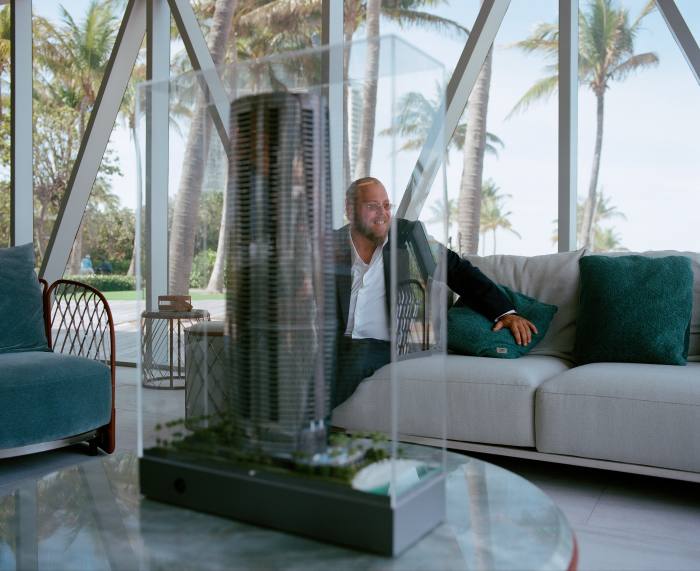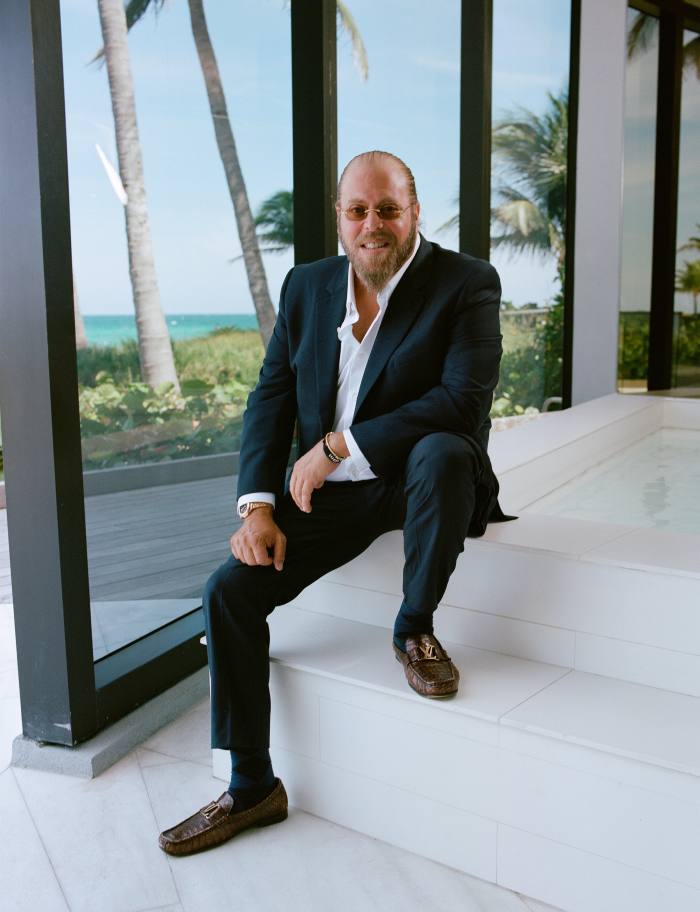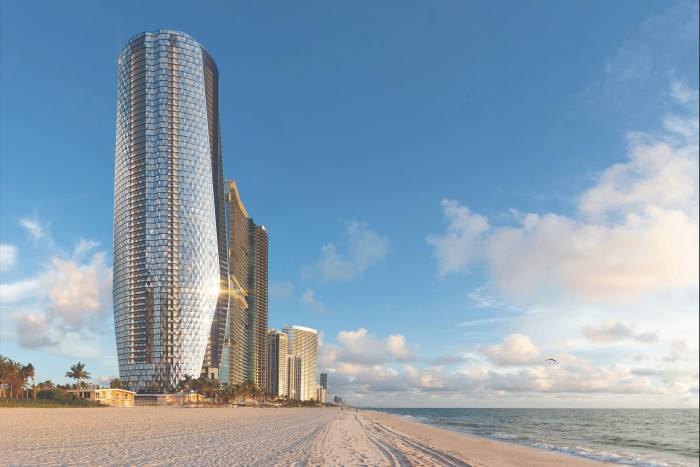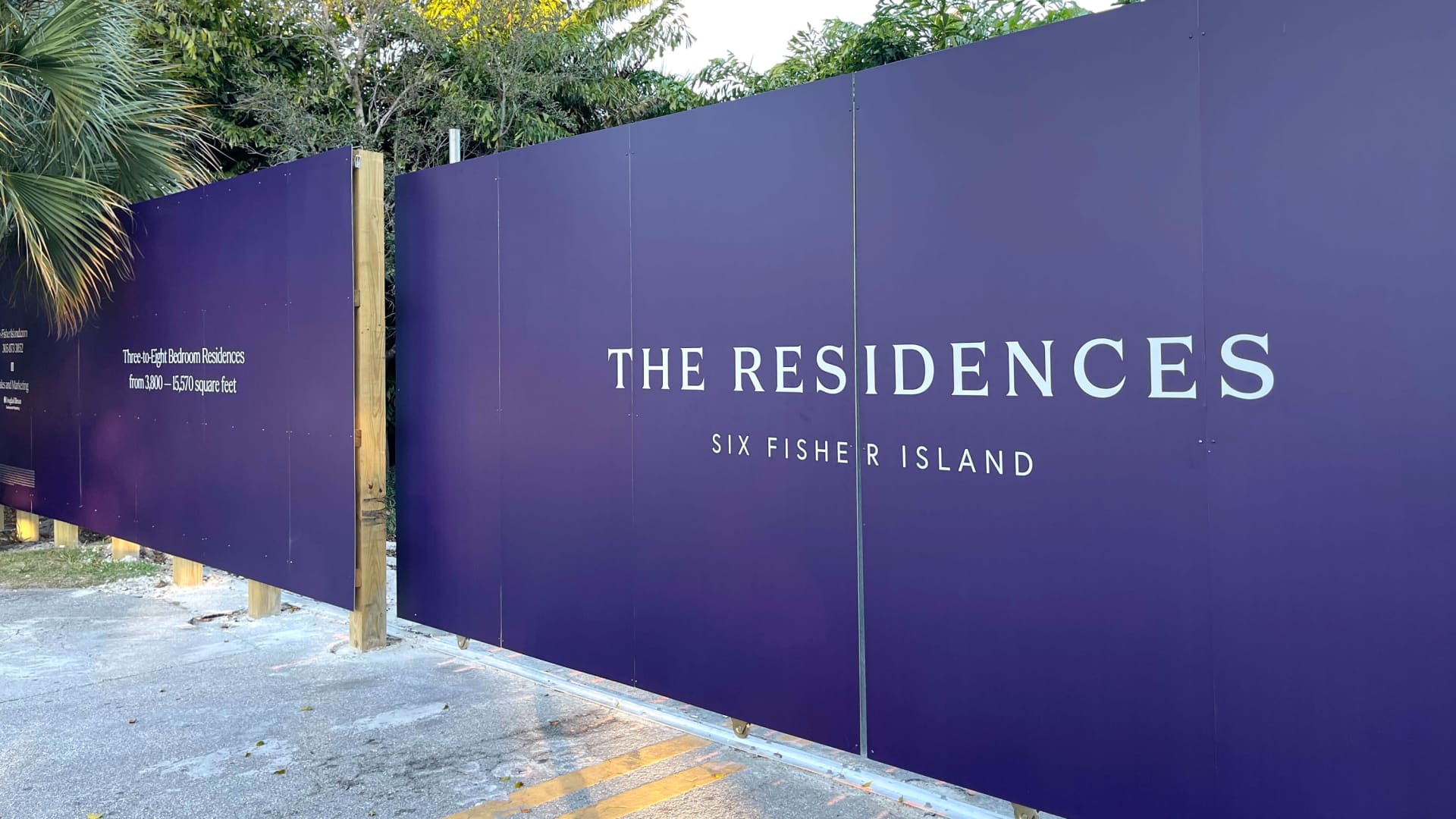Gil Dezer: the man who’s building a new luxury Miami
Gil Dezer was on his knees, mesmerised by marble. That is, a succession of travertine tiles that had been cut from a quarry in Italy, numbered and then reassembled some 5,000 miles away in the lobby of a high-rise tower in Florida. This was done with such precision that the stone’s vein ran in a seemingly uninterrupted line extending some 300 feet. “The fucking things are identical. Look at this!” Dezer said, shaking his head in awe. “It’s sickness.”
Savvy, obsessive and wildly uncouth, Dezer, 48, is the crown prince of Sunny Isles Beach, a roughly two-square-mile realm just north of Miami. Once home to sleepy motels, it now features a row of branded, Dubai-like luxury towers that stand as brash monuments to south Florida’s property boom. Many were conjured from the sands by Dezer and his father, Michael.
The one with the never-ending marble is the Dezers’ 56-storey Residences by Armani/Casa. It was preceded by a half-dozen Trumpy towers — Trump International, Trump Palace, Trump Royale and so forth. And there is the Porsche Design Tower, which features the innovation that Dezer will be remembered for when the definitive chronicle of this gilded era is written: The Dezervator.
This is a patented elevator that whisks car and driver from the Porsche Design Tower’s garage to their apartment, depositing them just outside the living room. That description — while technically accurate — does not quite capture the glee of a ride on the Dezervator. I took mine seated in a Porsche SUV. We were pulled aboard by a robotic dolly; the doors closed; and we zoomed up 38 floors in a glass-sealed cabin, spinning as we went. As the floors whooshed past I was reminded of Disney’s Space Mountain rollercoaster and the vacuum tubes once common at drive-through banks. Willy Wonka would have loved it.
The Dezervator is whimsy. But it is also, according to Dezer, a means to deliver what has become the ultimate of luxuries in an overheated Miami condo market in which en-suite saunas, hammams, wine cellars, multiple gyms, Japanese toilets, concierge service, yacht slips, polished mahogany, onyx sconces and the rest have lost their capacity to wow. That something is privacy. Thanks to the Dezervator, a Porsche Tower resident can drive into the building and emerge in their apartment without ever having to encounter another human being.
That appeals to football star Lionel Messi, who bought a Porsche unit. (Dezer cut him a deal in exchange for a few flattering social media posts.) It is apparently also appealing to others who are less recognisable but may still wish to avoid the gaze of, say, a jealous spouse. Or a business rival. Or the Venezuelan tax authorities. Or perhaps they simply wish to be spared the sad spectacle of the common man.
Miami developers boast about the care they take to ensure that their properties hermetically seal the ultra-rich from each other and the rest of us. Dezer gets this. “Privacy is a luxury. You should write that down,” he instructed me. Moments earlier, he had gestured towards another unanticipated luxury: a mattress-sized space in the interior laundry room of a $7mn flat. “This is where the South Americans put their maids,” he remarked. “It’s a thing.”
Dezer has found real-estate success like so many Trumps and Kushners before him: by being born into the business. But he made a reputation of his own by managing to steer that business through a 2008 crisis that felled many others and going on to become the foremost practitioner of a new Miami speciality: using lifestyle brands to sell high-end condos. If Porsche can be a tower, Miamians reckon, then so can Dolce & Gabbana, Diesel, Missoni and even the E11even nightclub. “Since this is a market that is so competitive, you need to differentiate yourself,” Edgardo Defortuna, founder of the Fortune International Group, a well-known Miami developer, explained. Like others, Defortuna was, at first, sceptical of Porsche and the notion that buyers would “like their cars right next to their living room”. But he has since reconsidered. “I have a lot of respect for Gil,” he said.
While rivals strain for the sophistication of Manhattan or Europe, Dezer embraces his inner Miami — that of Crockett and Tubbs, gold chains, fast cars and big boats. He wears his rusty mane pulled back into a ponytail and grooms his beard so that it juts to a demonic point. He has the broad back of an oarsman atop a body that tapers to a pair of dainty Louis Vuitton crocodile-skin loafers with “LV” buckles. You might cast a full-figured Jonah Hill in the movie version. An unreformed smoker of actual cigarettes, Dezer is also an unapologetic friend of the Trumps. Years ago he accompanied Donald, his then business partner, to the Miss Universe pageant in San Juan, Puerto Rico. “It was fun. He was single then,” Dezer recalled, without elaborating.
The mere mention of Dezer startles some in the Miami real-estate community. After they compose themselves, they tend to utter something along the lines of: “Oh, I couldn’t do what he does — I don’t have the right taste. But he does it very well . . . ” Really. One described that taste to me as “Porsches and man caves.” Even Dezer acknowledges that the Porsche Design Tower — a black cylinder on the skyline that has variously been likened to a piston and a phallus — is a bit alpha for some. “The wives didn’t want Porsche. It was too dark, too masculine,” he said. So he built the softer-hued Armani in 2020. “Every fucking room here is round,” he observed while leading me on a tour. “The New Yorkers love this shit.” Like Porsche, its multimillion dollar units sold out before it opened its doors. The total take was about $960mn.
Dezer’s latest project, the Bentley Residences, is a tower that will eventually rise 749 feet (about 230 metres) above the beach, or 100 feet higher than Porsche. At present, it exists only as an architectural model in a kitted-out showroom. Think of an enormous shimmering diamond, fallen from outer space and landed upright on a sandy beach. Surrounded, of course, by swimming pools. The building features standard Dezer fare: the Dezervator, the “Toto-in-all-bathrooms” loo policy, the splash pool on every balcony, the mesmerising views. But there are also new extravagances: outdoor showers, safes bolted into the floor and a residents-only restaurant by Todd English, the James Beard Award-winning chef. Each residence will come with four, not two, “parking spaces in the sky”. A three-bedroom goes for $8.5mn.
One might wonder what a British luxury car has to do with a condominium. Why not call the tower The Diamond, I ask, in reference to Bentley’s shape and black diamond motif? The brand is a short-cut, he explained. Without it, “I would have to spend a fortune creating that value in PR and advertising. Whereas, if you don’t mind spending a small amount, [brands] create that mystique for you.”
The Bentley has yielded more than $500mn in sales — or about 40 per cent of the inventory — in less than a year and before a single shovel has scraped the earth. If all goes to plan, construction will be completed in early 2027, which is the larger challenge that Dezer’s project may confront: timing. It is launching just as the US economy is slowing and a historic era of cheap money that bequeathed so many fancy loos and other baubles is now coming to an end. The warning signs are plentiful: tighter credit, the rising cost of materials, the fallout from the crypto crash, which hit Florida particularly hard. The Russian buyers who helped propel previous Dezer developments are no longer in the market, although the taint of impropriety they brought remains. (In May, the FBI raided a Trump-branded Sunny Isles condo owned by two Russian businessmen.)
Add to these the panoply of generalised anxieties of American life — catastrophic climate change, the spectre of the 2024 election, a plague of mass shootings — that rumble along beneath the surface at all times. A devastating crash would be in keeping with a tradition of south Florida property booms and busts that dates to the 1930s when men like George Merrick and Carl Fisher drained the swamps to build new cities from scratch. “Silicon Valley does technology. We do condos,” Peter Zalewski, a one-time Florida real-estate reporter who now advises distressed investors, told me. “When we go up, we go up spectacularly. And when we go down, we go down spectacularly.”
A few days before our meeting, Dezer had gone to see the current king of Miami developers, Jorge Pérez, in part to ruminate over the possibility of a near-term downturn. The Argentine-born son of Cuban émigré parents came to the city in 1968. Pérez went on to become the billionaire chairman and CEO of The Related Group. Thanks to a $35mn donation, his name now graces the city’s art museum. Dezer expressed reservations about a new project they are partnering on. Was this really the moment to embark on a building with units selling for $10mn to $13mn apiece? Pérez responded with a bracing pep talk, reminding the younger man of Miami’s singular virtues. “The guy was gung-ho,” Dezer recalled. “I’m telling you, I was ready to go out and buy everything I could.”
Then Dezer made the sort of prophecy that just begs to be tested: “This is not going to end any time soon. This is the new world.”
Like so many Miami stories, the Dezer saga began in New York. His father, Michael, the son of a bus driver, emigrated from Israel in the 1960s. He worked in advertising and then started a business that was a precursor to direct mail. The senior Dezer bought out competitors and eventually consolidated his holdings in part of a Chelsea office building. In a path familiar to other New York immigrant developers, he soon discovered that managing real estate was more fun and profitable than his first business. Today, the Dezers own about one million square feet of New York City office space, most of it clear of debt. Gil now runs the family business, Dezer Development, while Michael tends to a collection of more than 1,100 cars, including the world’s largest private assemblage of vehicles used in James Bond movies. Gil’s older sister, Leslie, manages the finances while another sister, Estee, oversees their New York holdings. “It’s good to have family watching the money,” he said.
The Dezers established their Miami toehold in 1985 when Michael bought an old Holiday Inn in Surfside. (It was adjacent to the Champlain Tower condo that collapsed in 2021, killing 98 people.) They renamed it Dezerland and gave it an Americana vibe. Gil was 10. “He was a Tel Aviv guy, and he said, ‘This reminds me of Israel,’” the younger Dezer recalled.
Later, Gil would attend the University of Miami where, distracted by the burgeoning South Beach nightlife, he did not show signs of being a great scholar. So his father obliged him to work at Dezerland and attend school at night. To this day, Dezer exudes the restlessness of a hotel or restaurant manager: Could you make sure the doors are closed in the sales room? Is someone fixing this? This glass is smudged.
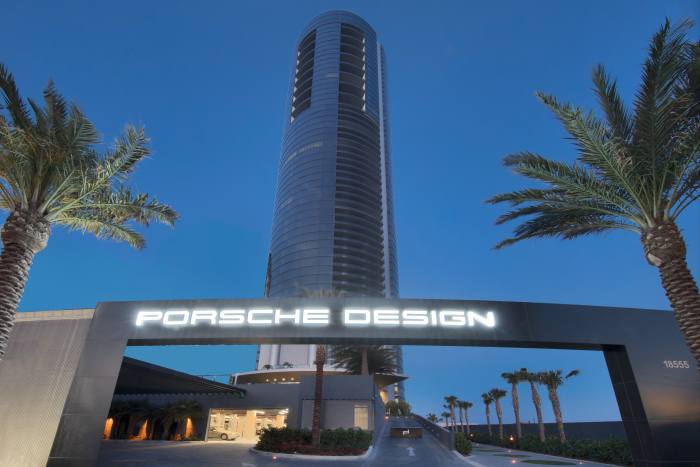

He is a walking reminder that, beneath the flash, property development is a schlep, its practitioners haunted by perpetual worries about contractors and subcontractors, design, financing, sales and zoning. Then, even if you get all that right, rising interest rates or a hurricane may still screw you.
From Surfside, Michael’s attention drifted to another community a few miles north called Sunny Isles. It featured a string of 1950s-era motels along Collins Avenue with Las Vegas-inspired names like the Stardust, Tangiers and Golden Nugget. In real estate terms, Sunny Isles was a classic fixer-upper. The beach was glorious, but the neighbourhood was rundown. Petty crime and vandalism were common. Part of the problem, naturally, was in the paperwork. As an unincorporated fragment of the wider Miami-Dade county, Sunny Isles did not have the legal standing to provide its own services, like policing and garbage collection.
In 1996, father and son began buying up struggling motels in the neighbourhood for a few million dollars apiece, starting with The Thunderbird. They also joined a campaign spearheaded by an energetic retiree named Dave Samson that succeeded a year later in incorporating Sunny Isles as the new city of Sunny Isles Beach. Samson, a one-time Chicago parking garage owner, became mayor and developer-friendly zoning laws followed. “They said, ‘Look, build as high as you like. Give us a tax base,’” Dezer recalled.
The Dezers continued to bank land. Along with the motels, they began buying old condos through an arduous process known as “condo termination” — in effect, convincing owners to sell, one-by-one, until you control an entire building. If you look closely, there are still traces of the old Sunny Isles kitsch. A trio of camels and their Bedouin guides stand outside the Sahara motel, although they now seem lost amid the shiny towers and midday traffic. Tucked beside the Armani is a shabby, low-slung motel that was long ago converted to a down market condominium. It seems only a matter of time before the Dezers pounce. They already own 10 per cent, enough to block another developer from making a play. Or, as Gil tactfully explained: “Nobody else is going to buy it because I’m there with a thumb up their ass.”
Trump entered the frame on one of the Dezers’ first Sunny Isles developments. It was a project known as the Ocean Grande Resort, which included a hotel and two condo towers and was to be managed by Sonesta Hotels. “Pre-sales” began in 1999. That’s when a developer tries to generate enthusiasm with little more than a rendering, lavish parties and a promise. The response was so-so. “We were about 40 per cent sold with the project, but we needed a shot in the arm,” Dezer recalled.
The elder Dezer had rubbed shoulders with Trump in New York in the 1980s, when the Queens-born developer was just becoming a Manhattan tabloid fixture. Now the Dezers caught wind that the Trumps were nosing around south Florida, looking for a property to which they could rent out their name. Soon the Sonesta Ocean Grande Resort became the Trump Ocean Grande Resort. It sold out. Trump turned up for the groundbreaking ceremony and, with his usual brio, boasted: “This will be the finest development ever built in south Florida. I love the Dezer family and I love the location.’”
The project coincided with Trump’s second act, in which a serially bankrupt property developer was reborn as a reality television star on the hit show The Apprentice. Its casting calls were held in Sunny Isles Beach. “Every Wednesday night the guy was on TV advertising my project,” said Dezer. “When we saw the attention it got, we realised branding works.”
It also coincided with a historic south Florida property boom. Miami developments with hundreds of units would sell out in a weekend. Condos became speculative, like tech IPOs. They appreciated so quickly that a unit might change hands three or four times before anyone ever moved in. Many buyers were Russian — so many that Sunny Isles Beach became known as “Moscow by the Sea” or “Little Moscow”.
“The joke is, ‘When does a Russian get a new Mercedes? When the ashtray’s full.’ They like brands,” Dezer told Hiten Samtani of The Real Deal, a leading property publication, in 2021. Trump, he said, was agnostic about where the buyers came from — as long as they bought. There were also wealthy Venezuelans, spooked by the rise of Hugo Chávez, and Argentines, at least while the peso was still pegged to the dollar. Credit was easy. Zalewski, the ex-reporter, recalled using cash advances from credit cards to make down payments on two condos he went on to flip a few years later. “Everybody was an ‘investor,’” he said, making air quotes.
Zalewski, who came from Chicago in 1993, has his own theory about the progression of Miami newcomers: the first year, they party; the second year, they either continue to party or they buckle down; the third year, many go home or to rehab. “If you make it through three years and you’re still standing, chances are you’re staying,” he said. “I’ve seen it over and over, and the crypto boys are just the latest ones.”
When the 2008 financial crisis hit, Miami’s housing market cratered, with cranes frozen and new buildings downtown standing empty. The city would become a graveyard of foreclosures and “short” sales, in which banks unloaded properties for less than the mortgage value simply to clear them from their books. Speaking to the Miami Herald in 2009, the overleveraged Pérez mused about the possibility of going bust, as Fisher and Merrick did in the 1920s. “When the music stopped, people got caught with their pants down,” Dezer recalled. He was talking about himself. Dezer had 1,200 Trump-branded units on the books. There was the 55-storey Trump Royale and then three identical Trump Towers that were built in a joint venture with Pérez’s Related. They were all under contract, but the buyers had not yet closed. “We sent out our closing notices on a Monday at Trump Royale. On Thursday, Lehman Brothers collapsed,” Dezer said. “Disaster. It was a complete disaster.”
Buyers abandoned their deposits and walked away. It seemed unlikely that Dezer would be able to repay two bank loans totalling $475mn for the Trump projects. There was talk of “handing the keys back” to the bank, as some developers are now doing with obsolete New York office towers. The loans were non-recourse, meaning the Dezers were not personally liable.
Michael Dezer, by then in his sixties, thought that was the sensible thing to do. “My father was ready to give up. He thought the banks would be aggressive in taking back properties,” Gil recalled. But he decided otherwise. He had a kind of faith that oceanside condos had an inherent value. With time, the panic would recede and buyers would return. So he spent the next 19 months doing the equivalent of bailing out a swamp, more or less returning to the plodding days of condo terminations. He set about trying to convince as many buyers as he could to close on units whose value had been cut in half. For those who had put down deposits on multiple condos, he offered to consolidate them on a single one. He allowed buyers to switch their deposits to smaller, less expensive apartments. He offered rent to own. Anything that would convince them to close. By his estimate, about 30 per cent of the original buyers stayed. Then Dezer had to hit the road to try to find new ones. “I remember my father saying, ‘I want to go on a cruise. Call me when this is over’,’” Dezer said.
The banks gave him time, but also set a price floor beneath which he could not sell. They ended up taking about 95 cents of every dollar. All the while, there were legal fights with attorneys who had found a lucrative new business helping condo buyers claw back their deposits. Dezer joked he was exhausting himself not to make money, but simply trying to lose less of it. One benefit the Dezers had was that they had bought their land early and at a low price, meaning they had more financial flexibility.
They were also rescued by Latin Americans, who showed up in force in 2010 armed with a robust real. “The Brazilians saved our ass,” he recalled. “They would come on Monday. Close on Thursday. And buy a Ferrari on Friday.” (A joke in the industry is that when you offered Latin Americans one condo, they would buy two.) The market bounced back far sooner than anyone expected.
In January 2011, Dezer paid off the last of his loans. Trump came down to celebrate with a “mortgage-burning” ceremony inspired by the one Trump held for a widower on a farm in Georgia in 1986. This being Miami, guests were entertained by fire dancers and spa treatments. For Dezer there was relief at avoiding the shame of foreclosure, but also something more. “It made me, me,” he said of the ordeal. “I was no longer Michael Dezer’s son; I was Gil Dezer.”
Dezer lives on three lower-level floors totalling nearly 15,000-square feet at the Trump Palace with his own pool and private garage, an arrangement that became the inspiration for the Porsche Tower. His parents are in one of the penthouses upstairs. It is a family joke that Dezer lives in their basement.
In 2007, Dezer wed the Argentine-born Lorena Strallnikoff at Trump’s Mar-a-Lago club in Palm Beach. For their second date, Gil sent a private jet to fetch her for lunch in Las Vegas, where he was doing business. They divorced in 2017. When I met Dezer, he had just returned with his daughters, 13 and 10, from a spring break trip to the Bahamas which, apparently, is where Miamians go when they need to get away from it all. He bumped into Jared and Ivanka in customs, as you do.
Dezer is a car guy like his father, except his collection numbers in the dozens, not the hundreds. Among his prized holdings is a Bugatti Veyron that stickers at $1.9mn. In 2009, Dezer won the Gumball 3000, a supercar rally on public roads that draws celebrities and wealthy gear heads for a transcontinental race punctuated by nightly parties. (It has attracted controversy, most notably in 2007 when two people were killed in Northern Macedonia by a speeding Gumballer.)
For those inclined towards scepticism, there are ominous signs for the business climate that enabled the younger Dezer’s rise. The collapse of cryptocurrency, for example, has not helped Miami’s campaign to turn itself into the world’s crypto capital. In a branding backfire for a city straining for substance, Miami was forced to find a new sponsor for its FTX Arena after the company’s crypto founder, Sam Bankman-Fried, was arrested in January and accused of running a Ponzi scheme.
And property prices are slipping, albeit from stratospheric levels. Units that were flying off the shelf a year ago are now lingering, say brokers. That is concerning for a luxury market where, like a new nightclub or restaurant, momentum is everything. If the “product” does not sell out in good time, then the remaining units begin to feel picked over. Soon, newer and shinier product appears in the display case beside them. “I think the bidding war world is over. There’s a big disconnect between buyers and sellers,” said Stuart Rich, a financing broker at Black Bear Capital Partners, who moved from New York in 2020 to co-head the firm’s Boca Raton office. “Prices went up so ridiculously high during Covid, and there was a lack of inventory.”
There are those in the New York real-estate world who cannot get past the belief that low-lying Miami is but one hurricane away from devastation — just as it was in 1926. Credit is a more immediate concern. Once abundant, it is now scarce. When Dezer recently approached Wells Fargo, his longtime lender, he discovered the bank was only willing to provide $100mn of the $550mn loan he needed for the Bentley — and at higher rates than in the past. (Dezer, who is Jewish, referred to offers from an emerging crowd of alternative lenders as “Shylock money”.)
Still, there are reasons Miamians are convinced this time will be different. The chief one is that affluent people are actually moving to Florida. By contrast, previous booms were fuelled by speculators or political and economic instability in Latin America. This time, the typical buyer is an employee at a New York hedge fund who has relocated to south Florida to take advantage of its warm climate and low taxes. “It was all flight capital. There was no foundation to what was happening. Now there is,” said one leading broker, despairing that a luxury building he was marketing did not have enough multimillion dollar units to meet demand. “If I had ten penthouses, I could sell them.”
As this person tells it, Miami cleaned itself up after the devastation of the great financial crisis. It was its best self when New Yorkers, Chicagoans and Californians came to ride out the pandemic. Many have decided to stay. In turn, their sophistication and standards are lifting the city to new heights in the form of world-class restaurants, arts and culture. Ken Griffin, the founder of Citadel, the hedge fund that moved from Chicago to Miami last year, is one of the heroes in this narrative. So is the Major Food Group, the New York restaurateurs who imported Carbone, the hip eatery. Miami has gained a gravity it previously lacked. “The reason it was boom-and-bust is because Miami was driven by bad shit happening [elsewhere],” a top Manhattan developer said. “But today Miami is a real city. It’s passed the tipping point.”
Goldman Sachs seems to agree. While it is forecasting double-digit declines for home prices in Austin and San Francisco this year, it is predicting a 0.8 per cent gain for Miami and a 2.4 per cent bump next year. “Florida has definitely had a history of boom and bust. But this time I do believe we are better off than most because we have growth — and sustainable growth,” said Suzanne Amaducci, a real estate attorney at Bilzin Sumberg (and a New Jersey defector).
Optimists also argue that Florida has learnt from 2008. Most developers, Dezer among them, now demand a 40 to 50 per cent down payment, up from the 20 per cent that was customary before. (It is made in five instalments and meant to discourage speculation.) For developers, the chunkier down payment may also reduce the need to borrow since they can use part of the money to fund construction. “We put a lot of guardrails on development after the great financial crisis,” Amaducci said.
Of course, it is the nature of a bubble that people always believe this time is different. Dezer seems to be of two minds about what is to come. In addition to higher financing costs, he is also grappling with Florida’s broken property insurance market. Construction coverage that cost Dezer $5.8mn for Porsche is now being quoted at a staggering $45mn for the Bentley. “Yes, there might be some buildings that might not make it through this. Or there might be some buildings that only get to 50 to 60 per cent [sold] and get stuck,” he acknowledged. Not the Bentley, mind you.
On a recent afternoon, I was standing outside the Porsche Design Tower under just the sort of sun-filled sky that might persuade a New Yorker to move. Valets dressed in black trousers and white polo shirts were navigating a Maybach through a pack of glossy SUVs. Lamborghinis and Ferraris looked on like lazing predators. I found myself trying to work out who was filthy rich. It was not obvious.
Was the older man in shorts and a T-shirt standing on the sidewalk a dressed-down Brazilian oligarch, I wondered, or a peon who had come to polish Messi’s boots? What about the young men with cropped hair lounging in the back seat of a Range Rover? Or the couple smoking cigarettes on the sidewalk beside me and speaking what sounded like Argentine Spanish? They did not look especially fancy; maybe that was the point.
The Porsche Design Tower was born from the ashes of 2008. Dezer did not have a specific plan but was determined to build something that would stand out amid a glut of empty condos. And he wanted to target the “uber-wealthy” — people quasi-immune to economic shifts. “After the crisis, I said to myself: I can’t keep hawking $1mn to $2mn units . . . Doing the same shit over and over again and thinking you’re going to charge two times for it,” he said. “People are going to laugh you out of the room.”
Through his brother-in-law, Dezer heard that Porsche Design, a subsidiary of the automobile marque that makes branded sunglasses, pens and other accessories, was looking to emblazon a condo tower. A project they were considering in Dubai had failed to materialise. Dezer made his way to Porsche’s studio in Zell am See, Austria and, after 18 months, struck a deal. His Trump pedigree was helpful. “We all had to think and say: what does Porsche have to do with real estate?” Dezer said.
The tower has a restaurant called Fuel and a bar called Octane. The interiors feature red leather, stained wood and black furniture that approximate the colours of the Porsche badge. But it is the Dezervator that somehow ties it together. It was Dezer’s idea, and built with contributions from Mid-American Elevator in Chicago and Germany’s Palis. The glass cab is not only air-conditioned and fitted with mobile phone receivers, but also designed to contain a burning car for two hours. Scanners sweep the floor before each car is ejected.
Dezer recalled bringing his plans to the city of Miami’s elevator department for approval: “These were elevator guys, you know? They were frothing at the mouth. This is the coolest thing they’ve ever seen.”
The tower’s sales totalled $840mn. It also allowed Dezer to move beyond Trump just as his politics turned his brand toxic for roughly half of America. To keep the Trump International hotel booked, Dezer has used Facebook to appeal to the other half. A casual visitor might notice that the hotel has increasingly begun appealing to travellers who keep kosher. Other changes are afoot. Soon the Thunderbird will be demolished to make way for the Bentley. The Sahara will eventually join it. Its camels have already been promised to the city. Out with the old Sunny Isles, in with the new.
Dezer has bigger dreams. He has filed plans for a new $1.5bn development called Uptown Harbor on the grounds of a dated shopping mall his family owns in north Miami Beach, just across the water that separates Sunny Isles Beach from the mainland. The plan is to dig a canal, making way for boat slips and promenades on its banks, five towers and 2,000 apartments. Its 28 acres would become a fully fledged neighbourhood.
Dezer talked me through it as he steered his electric Porsche through traffic at predictably high speed. Cigarette smoke drifted out of the sunroof. The name “Dezer” was emblazoned on the Porsche’s door jamb. Might Uptown be a tall order in light of the economy and rising rates, I asked? It would get done, Dezer assured, even if it took 10 or 15 years. For sure. A fellow driver leaned on their horn. Dezer brushed it off. “You can honk all day long,” he laughed. “The street’s named after me!”
Joshua Chaffin is the FT’s New York correspondent
Follow @FTMag on Twitter to find out about our latest stories first

